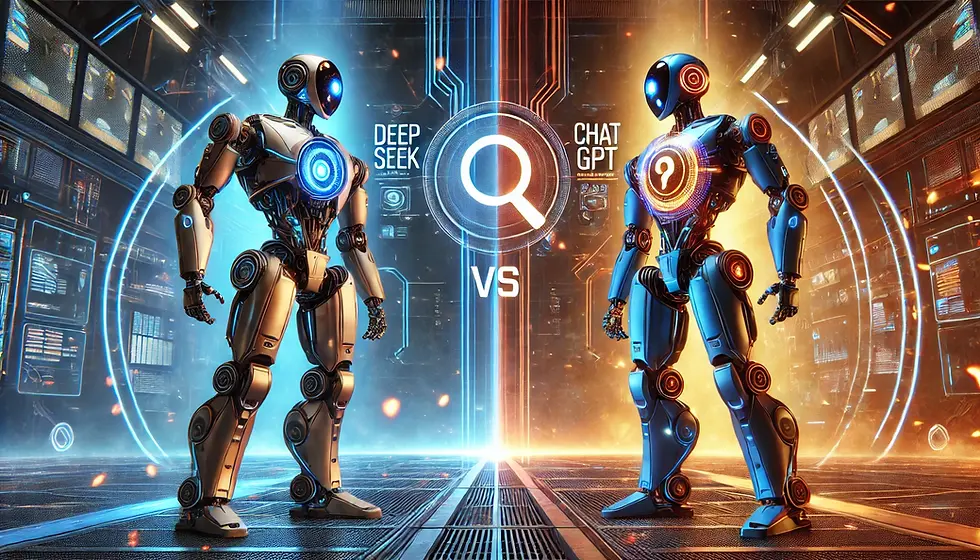AGI Unleashed: The Double-Edged Sword of Progress
- Aryan Tah
- Dec 27, 2023
- 8 min read

“Every aspect of learning or any other feature of intelligence can in principle be so
precisely described that a machine can be made to simulate it” (McCarthy). The term “Artificial Intelligence” or commonly referred as AI was written by John McCarthy, an American computer scientist and cognitive psycholgist. The origin of AI can be attributed to a convergence of intellectual curiosity, technological advancements, and the quest to replicate “human-like” intelligence. The pivotal Dartmouth Conference in 1956 marked the birth of AI, bringing together scientists like John McCarthy, Marvin Minsky, Nathaniel Rochester, and Claude Shannon, who envisioned creating machines with cognitive abilities on par with the human brain. The research for Artificial General Intelligence (AGI) originates from the ambition to create machines that have comprehensive cognitive abilities similar to human intelligence. Unlike narrow AI, which excels in specific tasks, AGI aims for machines capable of understanding, learning, and applying knowledge across a wide range of domains with human-like adaptability.
“Success in creating AI would be the biggest event in human history. Unfortunately, it might also be the last, unless we learn how to avoid the risks” (Stephen Hawking). As the world is reaching the peak of evolution, research on AGI continues. The use of AI is increasing by the day as its functionality expands and our dependence on new technologies increases. New models for AGI are being created and trained to be smarter, efficient, and more capable than humans which raises concerns regarding the threats faced by such powerful tools. AGI usage is increasing in every field and being introduced in tasks we never thought could be automated like customer service, healthcare diagnosis, trading, cybersecurity, fashion designing, etc. As a result of the expanding AGI usage throughout the globe, individuals are slowly getting dependent on it. AGI learns from experience, enhancing itself with time. The owners of private companies of AGI platforms incline more towards believing in the benefits of AGI towards humanity and providing solutions to the threats posed by AGI. On the other hand, many journalists and researchers provide more insight on threats posed by the new technology and how it could impact society permanently, they are skeptical about the growing power of AGI. The true intelligence of AGI is yet to be revealed which will help advance in research, innovate new ideas and bring evolution but at the same time, there can be a potential lack of control over AGI systems once they surpass human intelligence.
Can AI be controlled as development on AGI advances?
“Our best safety work has come from working with our most capable models. That said, it’s important that the ratio of safety progress to capability progress increases”. As research on newer models advances, the usability of AGI increases too. Its potential to understand and interpret real world problems improves with usage and testing. This aims for a positive impact on how problems are solved and viewed as. While many are still unaware of its true potential towards intelligence, we can align it to our needs and expectations from AGI to benefit humanity in the long run. Altman proposes a rapid learning strategy with careful iteration and a feedback loop to navigate challenges related to the deployment of AI, such as ethical considerations, bias, and societal impacts. The transition of AI to the real world when done gradually will give individuals, policymakers, and institutions time to understand what’s happening, personally experience the benefits and downsides of these systems, adapt our economy, and to put regulation in place. The time given will help society and AI to co-evolve, and for people collectively to figure out what they want while the stakes are relatively low. The application of certain restrictions while model training and implementation alongside gradual development will certainly help put barriers on the control over AGI and its usage.
“AGI has the potential to give everyone incredible new capabilities; we can imagine a world where all of us have access to help with almost any cognitive task, providing a great force multiplier for human ingenuity and creativity.” With the access and availability of AGI to society, it could amplify human capabilities, leading to breakthroughs in various fields and endeavors. Research that once required hours of analysis, data collection, and interpretation can be done in a shorter amount of time with accuracy, proportionally boosting efficiency. It acts as a catalyst which aims to provide solutions to problems such as finding a cure to a disease by enhancing diagnostic accuracy or improving treatment plans. New advancements are developed towards personalized education. AGI can test various algorithms into systems with real world examples and people, it can analyze the amount of knowledge a person has and determine the key methods that suit the individual to maximize learning process efficiency.
AGI is expected to turbocharge the global economy. The advanced capabilities of AGI could lead to increased innovation across various industries, fostering economic growth on a global scale. The deployment of AGI in industries will positively impact its working ability to analyze and adapt to dynamic environments, optimize processes, reduce costs, and improve overall operational efficiency. Businesses can develop powerful models with the guidance of AI. Competition will rise among companies that leverage AGI to enhance their understanding of customer behavior, market trends, and operational efficiency leading to more informed and strategic decisions. Furthermore, this will cause an impact on society as a whole and advance toward an evolution which leads the road to advancement and improvement of humanity. Products can be made and delivered quicker than ever using AGI. End-to-end programming will soon be obsolete as the development of AGI improves. The introduction of low code platforms enable businesses to get the base code for the personalized design they want with minimum coding required.This enables the companies to be able to serve their clients faster which leads to the economic growth of companies.
“Neoliberalism has a knack for mobilizing technology to make society’s miseries bearable.” AGI ideology aligns with the perspectives of neoliberalists, that concludes AGI as an inevitable and universally beneficial force which leans towards a solutionist approach. This means that instead of fundamentally changing societal structures or addressing issues, technology is rather used as a tool to provide immediate but temporary relief to problems. When we look at what happened with Uber, we can get a deeper understanding of market-bias. Uber’s core missions committed to the idea of cheaper rides and its addition to many of the city's public transportation systems. The investors liked the innovation behind the concept of self-driving cars promising cheaper rates in the future. They further invested in Uber, covering up for their multi-billion dollar losses. Eventually, the dreams of self-driving cars and cheap rates turned out to be a pipe dream. As a result, the investors demanded for a return which forced Uber to increase the costs, leaving the users on sidewalks. Uber’s entry is emblematic of the adaptation bias inherited by neoliberalism ideals, placing an emphasis on efficiency over transformative changes. Uber's success highlights the larger use of technology to solve problems which is the key focus of neoliberalism.
Would you trust private sectors over public ones?
When it comes to trust, society would rather rely on the government rather than private entities. AGI increases the dependency on private sectors on a huge scale. If public institutions start becoming heavily dependent over private entities for AGI solutions, it may raise concerns about control, accountability, and transparency. Private companies will have more control than public sectors, posing significant challenges to maintaining a fair and equitable societal framework. The growing power of private companies in AGI could potentially weaken democratic values. This enables decisions about how to manage and use these powerful technologies, influencing more of the interests of corporations than by what the public demands. As time continues, the private sectors would be controlling the cost, marketing and data with the power of AGI. The companies care more about the profits they receive to return to the investors than about societal well-being. AGI promotes privatization, the involvement of the government for providing and managing these services decreases which transfers the power to private companies. They can operate as user-pay models which make the users pay for access to advanced intelligence solutions. The reliance on private companies to come up with innovation increases which enables them to control the development and deployment of AGI according to their advantage leading to a market bias.
Numerous companies are integrating automation into their systems which help with redundant work but at the same time pose risk to jobs. AGI may create a new spectrum of job opportunities but can it really substitute for all the jobs it has taken over? A job that can be performed by a machine more efficiently for a lower price is predicted to replace individual performance and capability in the future. Jobs that are redundant which don't require human creativity and emotions seem to be easily replaced by AGI models. The automated systems will be more efficient than humans in every way which would boost the productivity of the company and allow employees to focus more on “human-required tasks”. While the existence of AGI promises a new spectrum of roles for managing AGI development, it does not consider the numerous jobs that would get replaced. It would be mandatory to maintain a high-level skill-set and upskill to maintain your role in the corporate companies. It will become much harder to not get replaced, frightening the individual's perspective of AGI potential. From a business perspective, the cost savings associated with automation, such as reduced labor expenses and increased output, may incentivize companies to adopt AGI and automate certain job functions. The reduction in costs for labor would boost the economy but result in a job deficiency which would impact the chances of having job displacements quicker than the creation of new job opportunities as society works to adapt to the new systems and capabilities which AGI may propose and continue to advance in.
The debate essentially revolves around the benefits, risk, and ethical considerations related to AGI, as well as the ideological perspectives guiding its development. The answer to whether or not AGI should be further developed is not a black or white answer, it’s somewhere in between. We can develop robust ethical guidelines for AGI development that prioritize transparency, fairness, and accountability. The threats posed by AGI are one that cannot be ignored either: dependency on private companies, loss of jobs, ideology of neoliberalism and the market-bias created by AGI puts potential risks of not being able to control AGI. There are methods suggested to reduce the risks and maximize the benefits of AGI but it cannot yet be predicted as we are unsure about how society will adapt and evolve around AGI. A cautious and iterative approach to AGI development could be used, allowing for continuous and adaptation based learning.AGI development can be slowed or paused for careful evaluation. An ethical set of guidelines could be followed, and collaboration with the developers, policy makers, and researchers will maximize the safety for the AGI. We could involve the public in decision-making related to development to ensure a diversity of perspectives and to address concerns about inclusivity and fairness. By engaging the public, developers and policymakers can ensure a diversity of viewpoints and promote a sense of collective responsibility. Even after the complexities of AGI development to the ongoing commitment of monitoring, adapting, and refining strategies as our understanding evolves, there is no straightforward answer as to whether or not the development of AGI should be impacted by the risks or benefits but both of them should be taken into consideration. The only thing that will answer these questions is time, the development and enhancement of AGI will either be a world-changing evolution or a world-ending catastrophe.



Comments